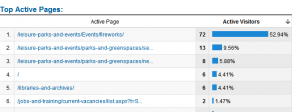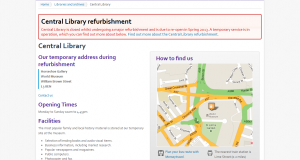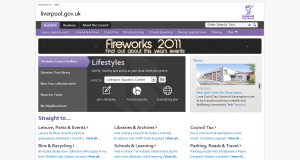Thanks to the wonder that is Google analytics real-time dashboard, we have been able to see that for most of the day 2/3’s of all visitors have been looking at the fireworks page on Liverpool.gov.uk. That’s a significant change from the normal traffic profile on the site.
[caption id=”attachment_197” align=”alignright” width=”300” caption=”Google Analytics - top three pages are fireworks.”]
Looking back to this time every year we know that the fireworks pages will probably account for ½ of the traffic for the whole day. It’s one of the few times in the year when the focus of our users moves to a single big event, and when designing the site we made sure we could accommodate these events, not only at the site level but at every level across the site.
The Council news stream
When building the evidence base for the website development, one of the areas we looked into was news. On our old site news accounted for only 2% of site traffic despite taking up 15% of homepage space – which for the majority of the time meant the site wasn’t really delivering what people wanted, more what the council thought they wanted - This was something we sought to change with the new site.
Moving news out of the prime part of the homepage was one thing but it did leave us with one issue. At key points in the year a news item will take special significance and dominate the traffic to the site and we had to be mindful of this when we redesigned the site.
The thing we noticed when we looked at these “super” news items was that they always related to service information rather than the traditional news items. It was at this point we decided to separate news and service alerts and build a system that let us put important information across any area of the site. Should the council need to tell people of significant changes to a service - we now have a facility to do this.
Service Alerts
[caption id=”attachment_200” align=”alignright” width=”300” caption=”A Page based service alert.”]
Based on this decision to separate news and service alerts we built the site to allow us to significantly change the focus of any page and deliver key service alerts to users as they navigate around the site.
On a service by service level this means we can tell users quickly and obviously when a service has changed or is being disrupted; for example when a library is closed we put it right across the library page, and if need be the whole section can carry an alert.
Then for the 3-4 times a year when something significant to the majority of site visitors happens we can put an alert across the homepage.
Homepage Alerts – use with caution
Changing the homepage structure isn’t something we do lightly, and putting the alerts on the homepage change the focus of the whole page;
Alerts on the homepage push services down the page and they push the “more…” link down the page and past the mythical fold – which depending on your page theory, isn’t that good – changing it this much means we are very sparing with homepage alerts.
Our base rule of thumb is – if the change/event is likely to take more than 50% of site traffic (or cause significant contact on another channel) then it will result in a service alert. For us that means it is usually…
- Fireworks
- Local election results
- Cold weather disruption
Really there are virtually no other events that significantly change the profile of the site. There are a couple of close calls, and really it’s something we have to make a judgement call on, but one thing is for sure, service alerts should never be used for ‘news’.
As we see it, adding the banner to the page makes it easier for the large portion of users to find the big in your face thing, but slightly harder for everyone else to find the service they want.
While that might only be a slight effect, you have to remember for Liverpool.gov.uk we get over 10,000 visits a day, and causing just 1% of those people to phone up instead of find what they want on the website, it an extra 100 phone calls to the call centre.
